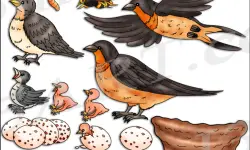When I first started birdwatching in Michigan, the flashes of red were the ones that always stopped me in my tracks. I remember standing along a quiet trail in the Lower Peninsula, the air still cool from the morning, when a Northern Cardinal burst from a thicket like a spark catching light. That moment pulled me deeper into the world of birding, where every shade of red feels like a reward for paying attention.
As I explored more parks, forests, and even suburban neighborhoods, I began to realize how many different red birds actually live in or pass through Michigan. Some showed up reliably at my backyard feeder, while others required patient hikes into conifer forests or careful listening in the high canopy. A few appeared so rarely that spotting one felt like discovering a secret written into the landscape.
This guide, 14 Types of Red Birds in Michigan (Pictures and Identification), grew from those personal encounters. It’s a blend of field experience, careful observation, and the small moments of excitement that every birder knows—the rustle of branches, a flash of color, the soft call that confirms you found your target. If you love red birds or simply want to see Michigan’s avian world in a new way, this list is the perfect place to begin.
Different Types of Red Birds Found in Michigan
Northern Cardinal

The Northern Cardinal is one of Michigan’s most familiar red birds, known for its vivid plumage and clear, whistled songs that brighten woodlands and neighborhoods year-round.
Identification Overview:
• Color: Males bright red with black mask; females brown with red accents
• Size: 8–9 inches
• Bill: Thick, conical, orange-red
• Wings/Tail: Long tail, rounded wings
• Habitat: Forest edges, suburbs, parks, shrubby fields
• Status in Michigan: Common year-round resident
The Northern Cardinal is easy to observe thanks to its habit of singing from exposed perches. Its bold colors and frequent visits to backyard feeders make it a favorite among Michigan birdwatchers. Males are especially territorial and sing loudly throughout spring and summer.
Across Michigan, cardinals thrive in areas with dense shrubs and open spaces for foraging. Their population has expanded northward over the decades due to warmer winters and increased backyard feeding, making them a familiar sight even during snowy months.
House Finch
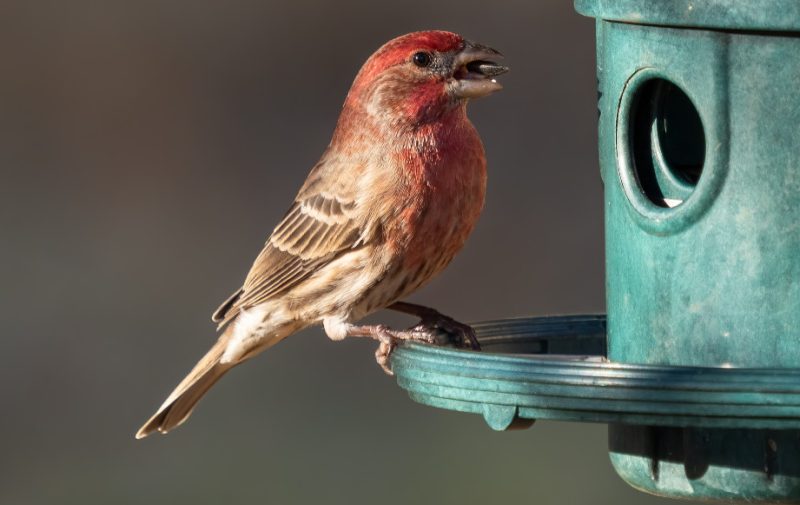
The House Finch is a small, social finch with rosy-red coloring in males and brown heavily streaked plumage in females, commonly seen around urban and suburban areas in Michigan.
Identification Overview:
• Color: Males rosy-red on head and chest; females brown and streaked
• Size: 5–6 inches
• Bill: Small, slightly curved
• Wings/Tail: Short wings, notched tail
• Habitat: Cities, suburbs, farms, residential areas
• Status in Michigan: Common year-round resident
House Finches are known for their sweet, warbling songs and flocking behavior. They often gather in groups on feeders, wires, or shrubs, communicating with constant chirps as they forage.
Adaptable and widespread, House Finches thrive in human-altered landscapes across Michigan. They feed on seeds, buds, and fruits, and their numbers remain strong throughout the state thanks to their ability to adjust to different environments.
Purple Finch
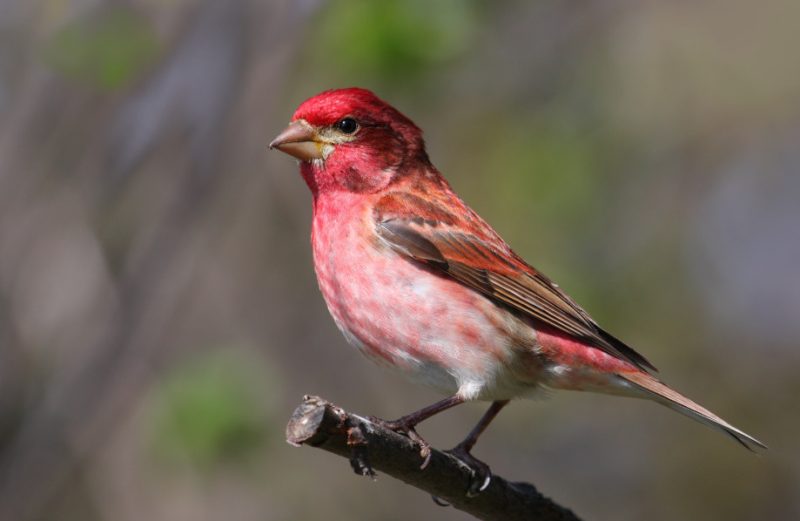
The Purple Finch is a richly colored finch with males showing raspberry-red hues and females marked by crisp facial patterns, often visiting feeders and woodland edges.
Identification Overview:
• Color: Males rosy wine-red; females brown with bold eyebrow
• Size: 5.5–6 inches
• Bill: Thick, tapered
• Wings/Tail: Short wings, slightly notched tail
• Habitat: Coniferous and mixed forests
• Status in Michigan: Common migrant and winter visitor; some in UP year-round
Purple Finches sing rich, rolling warbles from treetops, and their movements often occur in small flocks during migration. Their deeper red coloration and bulkier build help distinguish them from similar House Finches.
In Michigan, they appear most frequently in northern forests and may visit feeders during irruption years. Their presence varies depending on food supplies in Canada, making some winters exceptionally active with sightings.
Scarlet Tanager
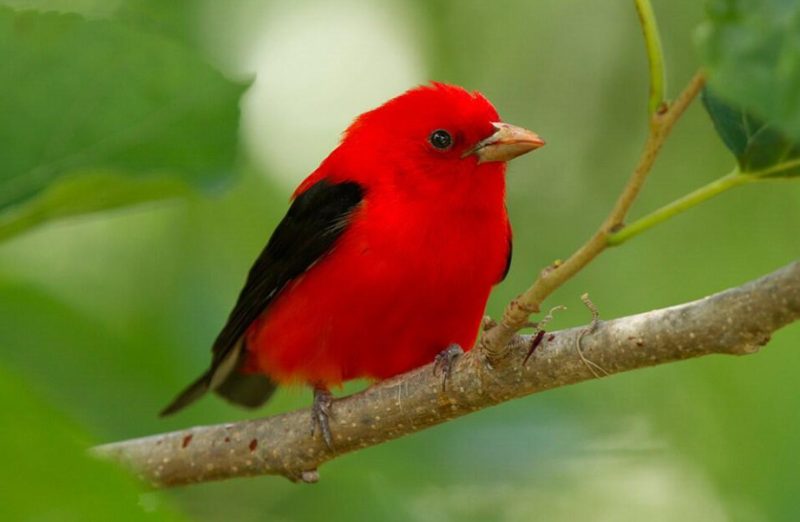
The Scarlet Tanager is a brilliantly colored forest bird, with males displaying intense red bodies and black wings during summer, often staying hidden in the upper canopy.
Identification Overview:
• Color: Males red with black wings; females olive-yellow
• Size: 6.5–7 inches
• Bill: Thick, pale
• Wings/Tail: Dark wings and tail (males)
• Habitat: Mature deciduous forests
• Status in Michigan: Summer breeder, statewide in forested areas
Though brightly colored, Scarlet Tanagers are more often heard than seen due to their preference for high perches. Their song resembles a hoarser version of a robin’s tune.
In Michigan, they arrive in May and remain through late summer, favoring large, unbroken woodland tracts. They primarily eat insects during the breeding season but shift to berries during migration.
Summer Tanager
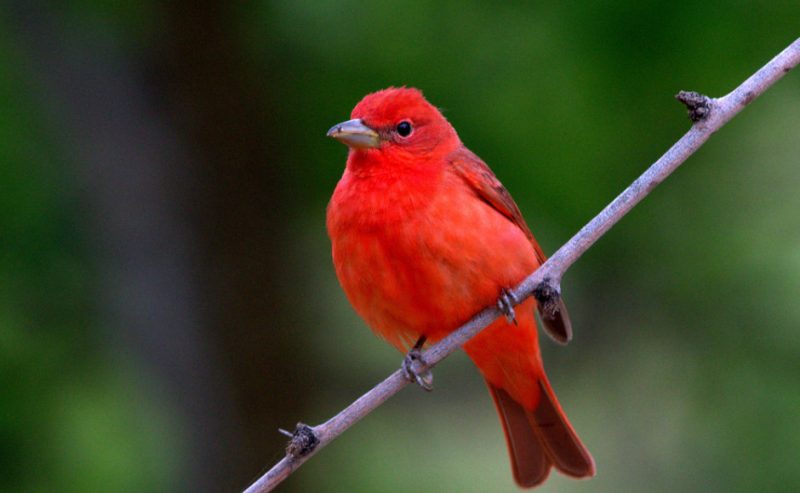
The Summer Tanager is the only entirely red bird in North America, with males showing uniform red plumage and females displaying warm yellow tones, making the species extremely distinctive.
Identification Overview:
• Color: Males solid red; females yellow
• Size: 6.5–7 inches
• Bill: Large, pale, slightly curved
• Wings/Tail: Uniformly colored with no black
• Habitat: Wooded areas, forest edges
• Status in Michigan: Rare visitor, mostly in southern Lower Peninsula
These birds move slowly among treetops and are known for catching bees and wasps in midair, removing stingers before eating them. Their song is smooth and melodic, somewhat similar to the Scarlet Tanager.
In Michigan, Summer Tanagers appear as rare migrants or occasional breeding-season visitors. Sightings often occur in parks and open woodlands where insect activity is high, making each encounter notable for birdwatchers.
Red Crossbill
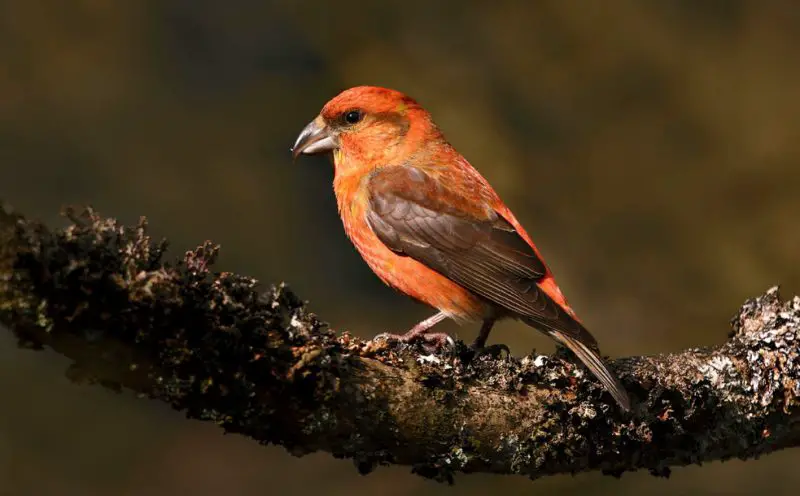
The Red Crossbill is a distinctive finch known for its crossed bill tips, which allow it to pry open conifer cones and extract seeds with impressive precision.
Identification Overview:
• Color: Males reddish; females olive-yellow
• Size: 6–8 inches
• Bill: Strong, crossed mandibles
• Wings/Tail: Dark wings, slightly notched tail
• Habitat: Conifer forests
• Status in Michigan: Irregular visitor, more common in the north
Red Crossbills travel in nomadic flocks, constantly moving in search of cone-heavy forests. Their metallic, chattering calls help birders locate them as they feed high in pine or spruce trees.
In Michigan, they appear most often in the Upper Peninsula and northern Lower Peninsula during irruption years. Their numbers fluctuate widely depending on cone crops in Canada and the northern states.
White-winged Crossbill
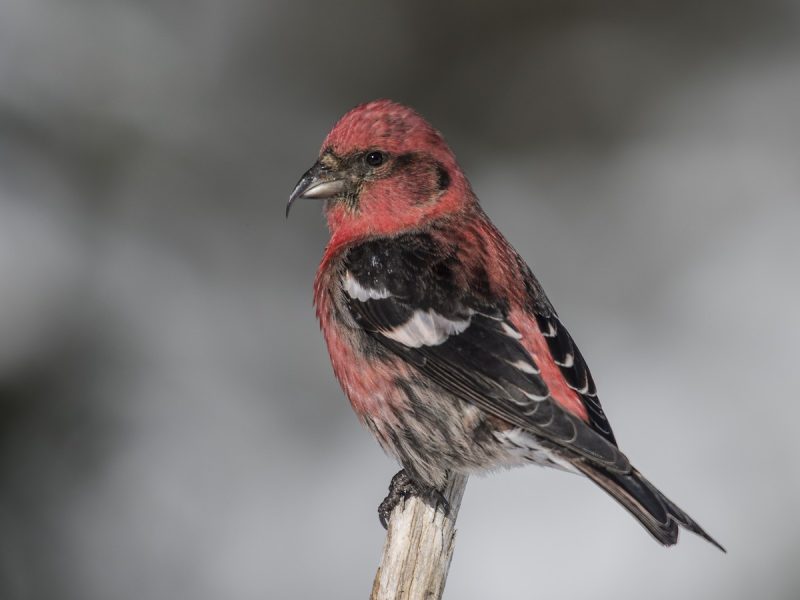
The White-winged Crossbill is a lively finch with bright red males, bold white wing bars, and a crossed bill specialized for extracting seeds from spruce cones.
Identification Overview:
• Color: Males red with white wing bars; females yellowish and streaked
• Size: 5.5–6.5 inches
• Bill: Crossed, thinner than Red Crossbill
• Wings/Tail: Prominent white wing patches
• Habitat: Spruce forests
• Status in Michigan: Unpredictable winter visitor, more frequent in the UP
These birds move restlessly through forests, often forming energetic flocks that chatter nonstop. They breed whenever cone crops are abundant, even in midwinter.
In Michigan, White-winged Crossbills appear in spruce-rich regions, especially the Upper Peninsula. Their presence varies dramatically each year, making them a favorite target for winter birders.
Pine Grosbeak

The Pine Grosbeak is a large, gentle winter finch known for the soft rosy-red plumage of adult males and the warm yellow tones of females and immature birds.
Identification Overview:
• Color: Males rosy-red; females yellow-gray
• Size: 8–10 inches
• Bill: Thick, heavy
• Wings/Tail: Gray wings with white wingbars
• Habitat: Boreal forests, fruiting trees
• Status in Michigan: Occasional winter visitor, mostly in the north
Calm and slow-moving, Pine Grosbeaks often perch quietly in fruiting trees or conifers, showing little fear of people. Their flute-like calls add a gentle sound to northern forests.
In Michigan, they appear mainly in the Upper Peninsula and northern Lower Peninsula during irruption winters. They favor mountain ash berries, crabapples, and boreal woodland habitats.
Common Redpoll
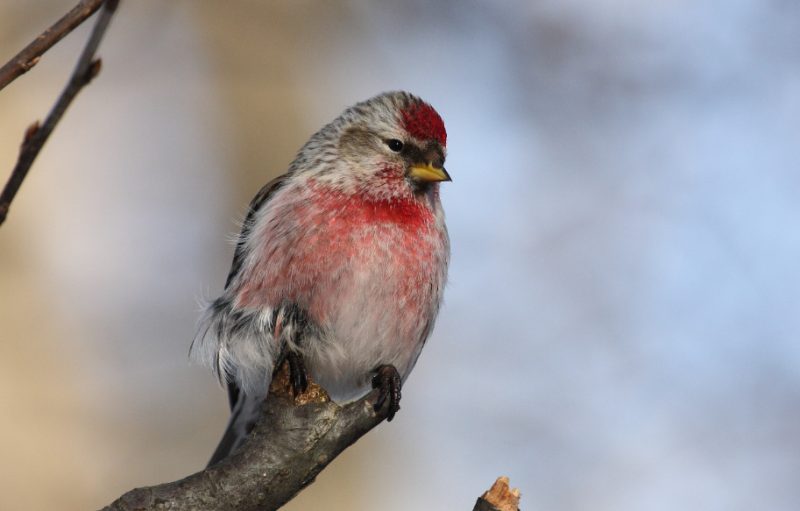
The Common Redpoll is a tiny, energetic finch with a red forehead patch, streaked plumage, and constant chattering that fills winter fields and forests.
Identification Overview:
• Color: Brown-streaked with red cap; males may have pink chest
• Size: 4.5–5.5 inches
• Bill: Small, pointed, yellowish
• Wings/Tail: Notched tail, dark wings
• Habitat: Open woodlands, birch thickets
• Status in Michigan: Irregular winter visitor, often widespread in irruption years
Common Redpolls move in fast, swirling flocks, often visiting feeders for nyjer seed. They cling to thin branches or hang upside-down while feeding, displaying nonstop activity.
In Michigan, they appear in variable numbers depending on birch and alder seed availability farther north. Some winters bring huge flocks statewide, especially in rural and northern regions.
Hoary Redpoll
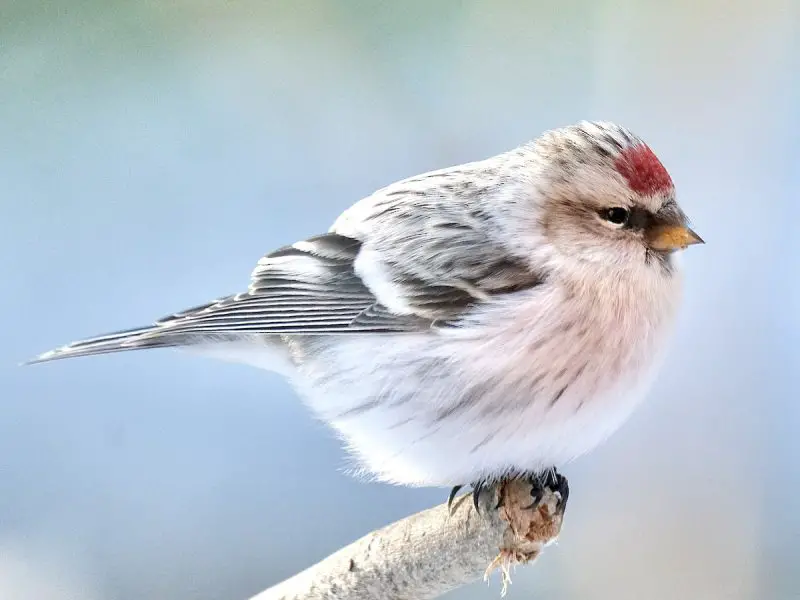
The Hoary Redpoll is a pale, frosty-looking finch that closely resembles the Common Redpoll but with whiter plumage and lighter streaking.
Identification Overview:
• Color: Very pale with red cap; males may show faint pink wash
• Size: 5–5.5 inches
• Bill: Very small, stubby
• Wings/Tail: Lighter streaking, notched tail
• Habitat: Arctic-breeding, visits birch and alder stands in winter
• Status in Michigan: Rare winter visitor, usually mixed with Common Redpoll flocks
More delicate and lightly marked than the Common Redpoll, the Hoary Redpoll appears clean-faced with a faintly frosted look. Its subtle features make identification challenging in the field.
In Michigan, Hoary Redpolls are scarce and usually found during strong irruption events in northern areas. They occasionally join large redpoll flocks, requiring careful observation to separate them from their common relatives.
Red-headed Woodpecker
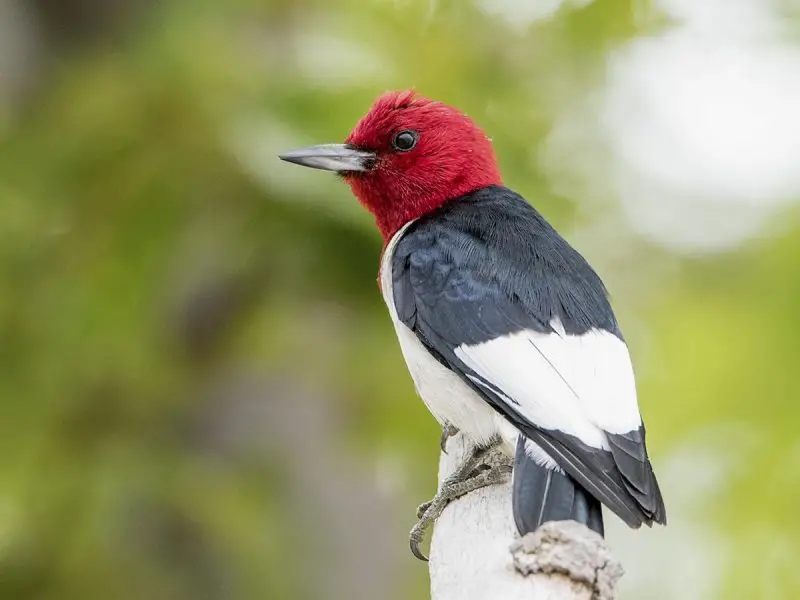
The Red-headed Woodpecker is one of Michigan’s most striking birds, instantly recognizable by its full crimson head contrasted against clean white underparts and glossy black wings.
Identification Overview:
• Color: Entire head red; body white; wings black
• Size: 7.5–9.5 inches
• Bill: Straight, chisel-like
• Wings/Tail: Large white wing patches in flight
• Habitat: Open woodlands, oak savannas, dead-tree stands
• Status in Michigan: Local summer breeder, more common in the south
Red-headed Woodpeckers often perch openly on snags or fence posts, making them easier to spot than many woodpeckers. Their strong, direct flight is distinctive and their calls are loud, raspy churrs.
In Michigan, this species is found mostly in the southern Lower Peninsula. Numbers fluctuate widely due to habitat loss, making every sighting a highlight for birdwatchers.
Red-bellied Woodpecker

The Red-bellied Woodpecker is known for its bold black-and-white barred back and the bright red stripe that covers the crown and nape, despite the name referring to its barely visible red belly patch.
Identification Overview:
• Color: Red crown and nape; barred black-white back
• Size: 9–10.5 inches
• Bill: Long, sturdy
• Wings/Tail: Strong barring, pale wingtips
• Habitat: Woodlands, parks, suburban areas
• Status in Michigan: Common year-round resident in Lower Peninsula
This woodpecker frequently visits feeders and is very vocal, producing rolling churr calls throughout the year. It climbs tree trunks with agility, searching for insects, nuts, and fruit.
In Michigan, it thrives in mature forests and suburban neighborhoods with large trees. Its range continues to spread northward, making it a familiar sight for many residents.
Vermilion Flycatcher
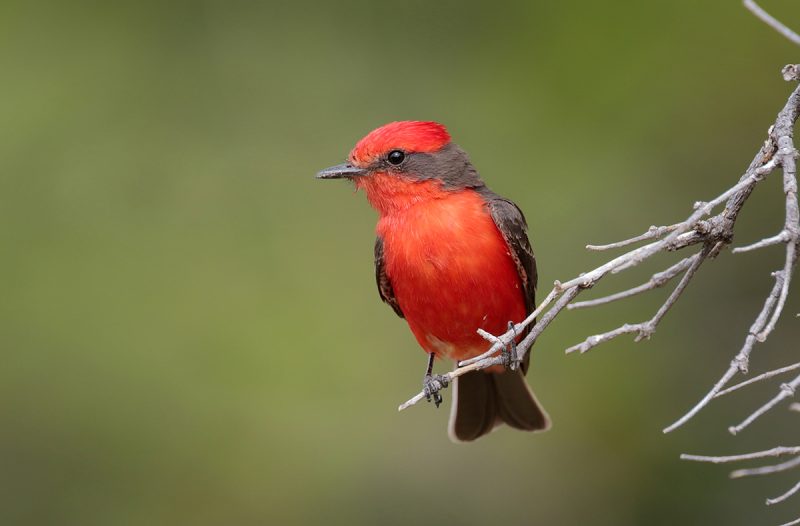
The Vermilion Flycatcher is a small, brilliantly colored bird with adult males displaying vivid red plumage and dark brown wings, though it appears only rarely in Michigan.
Identification Overview:
• Color: Males bright red; females gray-brown with peach belly
• Size: 5.5–6 inches
• Bill: Thin, pointed
• Wings/Tail: Dark wings, modest tail length
• Habitat: Open fields, marsh edges, scattered trees
• Status in Michigan: Rare accidental visitor, usually during migration
This species hunts insects by flying out from exposed perches, returning repeatedly in lively, acrobatic movements. Males may perform fluttering courtship flights accompanied by soft, musical notes.
In Michigan, Vermilion Flycatchers appear only on rare occasions when migration or weather events push them far from their southwestern range. Sightings are considered exceptional.
Hepatic Tanager
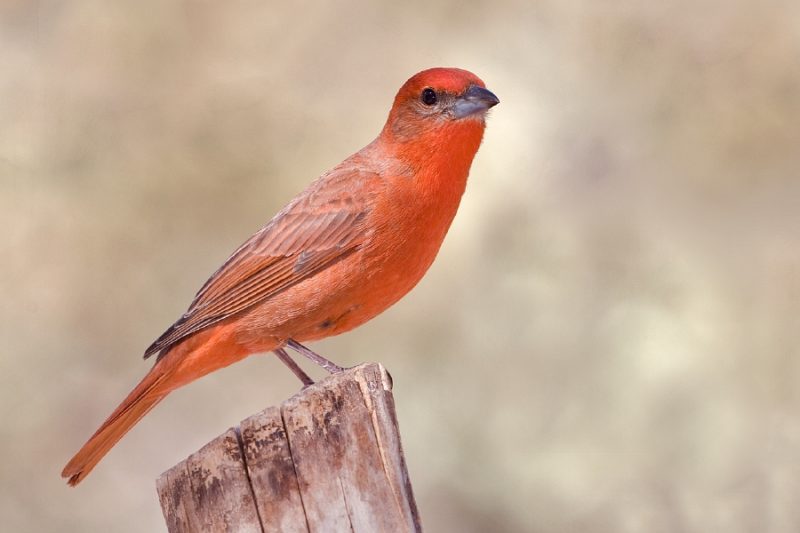
The Hepatic Tanager is an extremely rare visitor to Michigan, recognizable by the deep reddish-brown coloring of adult males and the warm yellow tones of females.
Identification Overview:
• Color: Males dark liver-red; females olive-yellow
• Size: 7–8 inches
• Bill: Thick, pale
• Wings/Tail: Uniform with minimal markings
• Habitat: Mature forests, mixed woodlands
• Status in Michigan: Very rare accidental sighting
This tanager moves methodically through treetops, foraging quietly for insects hidden among leaves. Its subtle calls and preference for canopy layers make it easy to overlook.
In Michigan, the Hepatic Tanager has only a handful of historical records. It typically breeds in the southwestern U.S. and Mexico, making any appearance in the Great Lakes region an extraordinary event for birders.
Tips for Spotting Red Birds in Michigan
Watching red birds in Michigan can be a rewarding experience, especially with the state’s wide range of habitats from dense forests to open fields and suburban areas. One of the best ways to spot these colorful species is to focus on areas rich in berries, seeds, or cone-producing trees. Many red birds such as finches, tanagers, and crossbills rely on seasonal food sources, so knowing where these plants grow can significantly increase your chances of seeing them. Early mornings offer the best visibility since birds are most active during feeding hours.
Another helpful method is to listen for distinct vocalizations. Species like Northern Cardinals, Scarlet Tanagers, and House Finches all have easily recognizable songs or call notes. Learning these sounds helps you detect birds even when they stay hidden in the forest canopy. Setting up bird feeders with nyjer, sunflower chips, or suet can also attract red-colored species to your yard, giving you close and reliable viewing opportunities throughout the year.
In winter, pay attention to irruption patterns. Birds like Red Crossbills, Pine Grosbeaks, and redpolls move unpredictably depending on food supplies further north. Checking local bird reports or citizen science platforms can guide you to areas with recent sightings. Patience is key, and taking binoculars to trails, parks, and nature preserves greatly enhances your chances of seeing these bold and beautiful red birds.
FAQs About Red Birds in Michigan
Why do so many red birds visit Michigan?
Michigan’s diverse forests, abundant berry-producing plants, and strong seasonal food cycles make it an ideal stopover for many species. Some stay year-round, while others migrate through or arrive during irruption years.
Which red bird is easiest to spot in Michigan?
The Northern Cardinal is the most consistently seen red bird across the state. It is a year-round resident and frequently visits feeders, parks, and backyards.
Are tanagers common in Michigan?
Scarlet Tanagers are fairly common in summer forests, but Summer Tanagers are rare visitors. Both species prefer wooded areas with plenty of insect activity.
When is the best season to spot red birds?
Spring and summer are ideal for tanagers and breeding finches, while winter is best for redpolls, grosbeaks, and crossbills that visit during irruptions.
Where should I go to see winter finches like redpolls or crossbills?
Northern Michigan, especially the Upper Peninsula and conifer-rich areas, offers the best chances. Birch and spruce forests often attract irruptive winter finches.
Why are some red birds only seen during irruptions?
Species such as Common Redpolls and Pine Grosbeaks move south when food sources in Canada decline. These unpredictable movements are known as irruptions.
Do all red birds eat seeds?
No. While finches and crossbills rely heavily on seeds, tanagers primarily eat insects and switch to fruit during migration. Diet varies by species and season.
Can I attract red birds to my backyard?
Yes. Offering nyjer seed, sunflower hearts, suet, and berry-bearing shrubs can draw many red species. Planting native trees and reducing pesticides helps attract even more birds.
Are rare visitors like Vermilion Flycatchers ever predictable?
No. Their appearances in Michigan are accidental and unpredictable, usually caused by storms or unusual migration patterns.
Is it possible to see all these species in one year?
It is unlikely, but dedicated birders can see many of them by combining backyard watching, seasonal birding trips, and monitoring irruption reports.
Conclusion
Red birds add a striking burst of color to Michigan’s forests, fields, and neighborhoods, making every sighting feel special. Whether you are watching a bright cardinal in your backyard or searching for irruptive crossbills in the northern forests, each species offers its own charm and challenge. By understanding their habits, learning their calls, and exploring the right habitats at the right times, you can greatly improve your chances of observing these vibrant birds. With patience, curiosity, and a bit of seasonal awareness, Michigan becomes an exciting landscape filled with flashes of scarlet, crimson, and rosy-red across the year.



